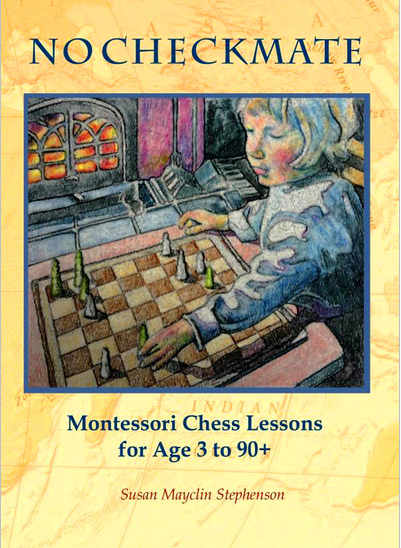NOT JUST CHESS!
This book can tell you how to teach chess to any child in a Montessori way.But if you look past the chess, you can use this book as an insight to teach your child anything, using the Montessori method.The book introduces the game of chess using: grace and courtesy of handling the chess pieces, and the social aspect of the game; practical life— polishing/dusting the pieces, setting up the environment; language, using the three-period-lesson to learn the names of the pieces; mastering the game by building up one difficulty at a time.This is the essence of Montessori.If you are not interested in learning chess this book is still a gold mine of knowledge and insight into the Montessori method and how to offer any skill to a child. As always, this author welcomes you into the world of the child and how to help spark their interest.
—Joanne King, Montessori primary and elementary teacher and consultant, the Netherlands |
FROM A DAD/TEACHER
If you are looking for a book that will help you to introduce the game of chess to your child—in a non-competitive, gradual, and fun way—you have found it!Deep respect and understanding of human development in its formative stages is a common denominator of all Ms. Stephenson's books. In No Checkmate,you will find a conceptual framework of developmental characteristics along with a practical guidance in the form of preliminary games and activities, gradual introduction to the key rules of the game, and more. This book opened a new field of exploration and joy for me and my two daughters!
—Dmitry Ostrovsky, father, philosopher, Montessori elementary teacher, Israel and Russia
Susan covers every detail of making this game meaningful and fun for the adult and even the very young.
— Rita Zener, PhD, AMI (Association Montessori Internationale) Teacher Trainer |
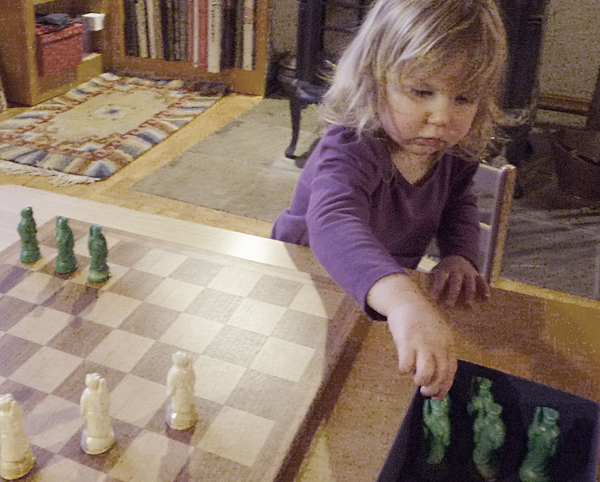
(From page 21)
Graceful movement and balance of the whole body
At around 1.5 years of age a child, so glad to be in an upright position with hands free, wants to put forth as much effort as possible and delights in carrying heavy things. This practice solidifies the balance of walking, carrying something, and watching where one is going. One of the first things you might offer a child in the learning of chess might be the opportunity to carry the chess set to the table, placing it quietly on the table, and putting it away when the game, between two other people, is finished.
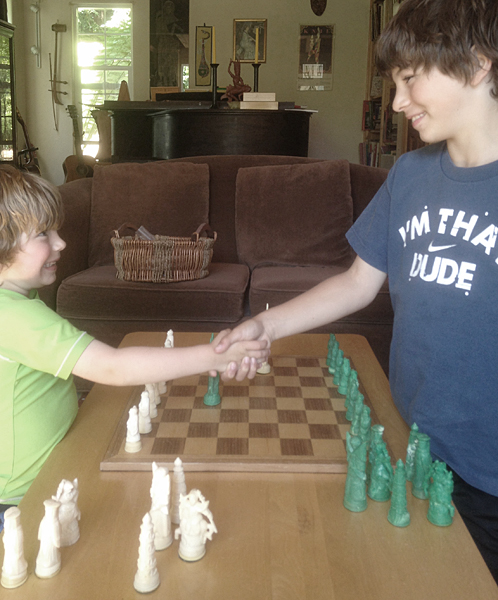
(From page 23-24)
The courtesy of shaking hands
When a child enters a Montessori class, at least in Western Cultures, the first thing he usually does is shake hands with the teacher who is sitting on a chair just inside the classroom so her face is at the child’s level. This marks the beginning of the child’s day at school; it sets the energy of mutual respect and focus on being in the moment. Similarly you can teach this in chess. Either person can offer to shake hands at the beginning of a game or lesson.
But the main reason for this is because the manners of chess require that at the end of a game the two people shake hands and say something along the lines of, “Thank you for playing chess with me,” or, “I enjoyed playing chess with you.” This may not seem like a very important step in the beginning of learning to play chess, but it is extremely helpful when, at the 3rd level of chess, both people are trying to win, and someone loses. Knowing that one is going to end the game in such a polite manner can prevent the frustration, anger, and ill manners that are sometimes displayed when a person (even adults) lose a game.
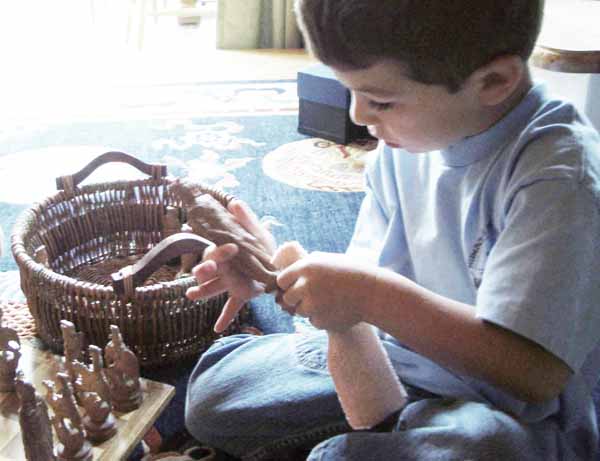
(From page 41-42)
Dusting or polishing chess pieces
This brings up a point that is sometimes misunderstood in a Montessori class. When a child asks if he can work with materials that he is not prepared for, for example wanting to get his hands on the beautiful glass beads that teach squaring and cubing before he has begun the basic math work the reply should never be, “No, you are not ready for that.” The child doesn't understand that in time he will have the skills to work with more advanced materials, that someday he will be ready. He only hears the word, “NO!” Instead the teacher says, “Yes, you will be able to work with those materials, as soon as you can do this, and this, and this” perhaps pointing to the beginning shelves of math materials. “This one comes first. Would you like a lesson on that now?”
Sometimes, if a child is not even ready to begin the first math lesson and still wants to “work with” the beautiful bead materials, the teacher can say, “Yes, do you see that these beads and the shelves are really dusty? Would you like a lesson on dusting them?" Sometimes children have been able to practice their skill of wood polishing on materials in the Montessori classroom that they will not be using in the prescribed way until much later. This is all satisfying, important, real work.
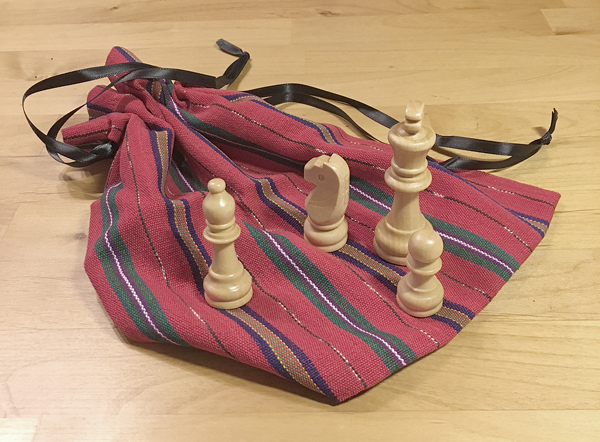
(From page 49-50)
The mystery bag, the stereognostic sense
This activity is given after the child has learned the name of the pieces, or is almost finished learning them. The stereognostic sense, in Montessori education, is defined as the ability to distinguish the shape, texture, and consistency of an object by running one’s fingers over the object when they cannot be seen with the eyes. This is a combination of tactile and muscular memory that is very strong in the young child who learns by touching. We do this by means of what is called a mystery bag.
Put the chess pieces in their box or container out of sight. Ask the child to choose three different pieces from the box and put them in the bag on the table between you. You should not be able to see what is missing from the box or what the child has chosen. Move the bag close to yourself and put one hand in the bag. Make a great show of handling the different pieces, moving your hands around them, trying to identify them. Finally, say, “Knight?” And then draw the piece out of the bag to see if you have identified the piece correctly. Do this with three all three pieces. Then put them back in the box.
Ask the child, “Would you like me to choose some and you name them?” Then continue with three pieces up to all 6 pieces, repeating as the child chooses.
(From page 92-93)
Introducing the concepts of check and checkmate
Level 2 chess is a real chess game and the whole world of chess begins to open up at this point. The goal of all traditional chess games is to get one’s pieces into positions so that the partner’s king will be removed or captured in the next move, and there is no place for him to move to avoid this, and it is not possible for one of his other pieces to help him. Interestingly the word checkmate is thought to come from Persia, where the game had spread from India. Shah is the word for king and mat meant helpless or defeated. So Shah mat, which became checkmate, means the king is defeated. This kind of information will attract the child above the age of 6 when the interest in history and etymology is the foundation for Montessori education at this age.
To be in check means to be in danger of being removed by one's chess partner in the next move. When a king is in check he must do something about this in the next move. In some places it is considered polite to tell a chess partner when a king is in check. In other places it is considered rude. Checkmate means that the king will be taken in the next move, no matter what is done. The player who has put him in checkmate does not remove the king, the losing chess partner merely lays his king down on the square where he was standing.
When our second grandchild Tai was 4 years old and visiting us in California from Portland, Oregon, a friend, a teenage girl, visited us and Tai asked her if she would like to play chess. They sat on the sofa for some time playing and at the end of the game Tai came to me with such a sad face and said, “She didn't play level two.” The teenager looked at me in some confusion because she didn't like seeing Tai so sad and said, “I have never heard of ‘level two’. What does that mean?” And so I explained. |
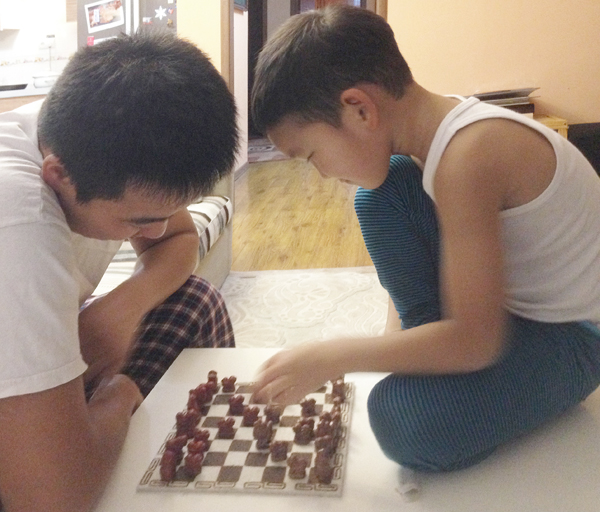
(From page 94-95)
Mongolia
In 2015, I was in Mongolia to give the first AMI Montessori public lectures and to consult with two schools. I was staying with a family who had a 5-year-old boy whose grandfather had taught him the chess moves. One evening that the boy and his father were playing chess in the living room, Ermuun suddenly exploded into anger, stomping and yelling and his father looked toward me with a puzzled look on his face. I asked what happened and the father said, rather sadly, “He doesn't like to lose.” My reply was that winning and losing was not appropriate at this age, but the emphasis is better placed on spending fun time with one’s father, and learning more and more about chess. And, with his interest aroused I went on to explain the “Three Levels of Chess” that our family has developed over the years. Later I received news from Mongolia that the boy enjoys chess now much more than before.
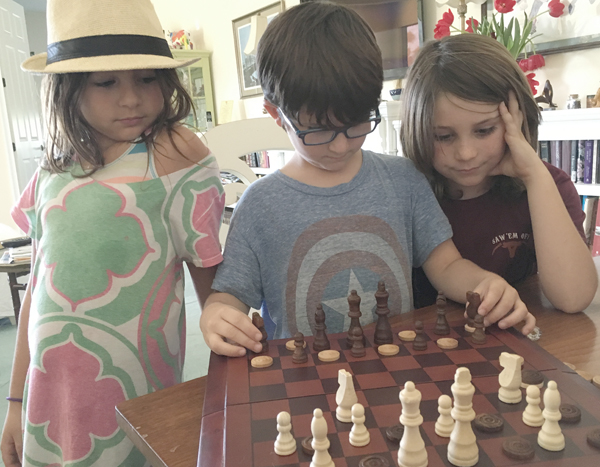
(From page 115-117)
Creativity - Oden’s game
Chess has changed many times since its birth in India and it is still changing. The rules have changed and why cannot children continue to change them? Recently I was playing chess with my sister’s grandchildren. One the youngsters, already identified as a unique and creative thinker, decided to make up his own game. I had given them a combination chess and checkers set and he wanted to created a way to use all of the pieces of both sets in one game.
I explained that all games were the result of agreement between people about how the game is played. An example is the rules of Scrabble in our family. Scrabble is a word game in which two to four players score points by placing tiles, each bearing a single letter, onto a game board which is divided into a 15×15 grid of squares. The tiles must form words which, in crossword fashion, flow left to right in rows or downwards in columns. The words must be defined in a standard dictionary . The game is played without access to a dictionary unless a word is being challenged.
But a year ago I suggested that this way of playing limits the players to words they already know, so our family began to play with the dictionary as our constant companion, accessible at any time. This was a cooperative way of playing, and it was so exciting for all of us to learn so many new words in one game that winning became secondary. It was still fun to find words that could score a lot of points and have a high score at the end of the game, but there was much more learning and enjoyment of Scrabble from then on.
So why not a game with chess pieces and checkers together? All I remember, as I heard him explain his new game to his brother and cousin, was “And the Queen has more power when she is standing on a checker!”
Benefits of chess
I once came across a list of 10 ways learning chess can benefit the brain. Here is the list:
- It increases creativity
- It improves memory
- It increases problem-solving skills
- It can raise an IQ
- It grows dendrites
- It can help prevent Alzheimer’s
- It exercises both sides of the brain
- It improves reading skills
- It improves concentration
- It teaches planning and foresight
These are all important results of learning chess. But in learning chess the Montessori way we can add to this list:
- It helps one learn patience
- It teaches body awareness and grace
- It teaches good manners
- It teaches cooperative problem solving
- It teaches how to help another
- It teaches one how to treat another person the way one would like to be treated
And maybe you can think of even more.
Newsletters announcing books
#13 Book, Child of the World: Montessori, Global Education for Age 3-12+, March 2013
#14 Book, The Joyful Child: Montessori, Global Wisdom for Birth to Three, July 2013
#15 Book, The Universal Child, October 2013
#21 Book, No Checkmate, Montessori Chess Lessons for Age 3-90+ May 2016
#23 Book, Montessori and Mindfulness, November 2017
#25 Book, The Red Corolla, Montessori Cosmic Education (preparation in the 3-6 class), June 2019
#26 Book, Montessori Homeschooling, One Family's Story , August 2020
#27 Book, Aid to Life, Montessori Beyond the Classroom, March 2021
#28 Book, Please Help Me Do It Myself, Observation and Recordkeeping for the Montessori Primary and Elementary Class, May 2022
Other Newsletters of interest
#2 Montessori Art, Jan 2010
#3 Montessori Cultural Geography, May 2010
#4 Montessori Parenting/Teaching, Aug 2010
#5 Montessori Home Environment, Nov 2010
#6 Montessori in Sikkim, Jan 2011
#7 Montessori Math, Apr 2011
#8 All 2009-2011 Newsletters, May 2011
#9 Montessori Grace and Courtesy, Aug 2011
#10 Montessori Biology, May 2012
#11 Practical Life, Real Life, Aug 2012
#12 Happy Children for the Holidays, Dec 2012
#16 Montessori Language, Apr 2014
#17 Swaddling, Caring for Others, Authentic Montessori. Nov 2014
#18 Concentration, Where the Magic Happens!, May 2015
#19 Michael Olaf Montessori Company, Nov 2015
#20 Cosmic Education, Feb 2016
These books speak to anyone wanting to understand Montessori. They are based on the author's fifty years of experience as a Montessori teacher and administrator, speaker, school consultant, and examiner for Montessori teacher training courses. Some have been translated in other languages, the English versions are available from Montessori book suppliers and online.
QUOTING BOOKS
Permission is granted to quote any of these books as long as a link is included to the original, or the information is given so that readers can find the original.
AUTHOR'S WEBSITE, Montessori work over the years, art and international blog, SUSAN
MICHAEL OLAF Montessori information MICHAEL OLAF
MICHAEL OLAF Montessori shop BOOKS & MATERIAL
Updated on February 17, 2023
|
